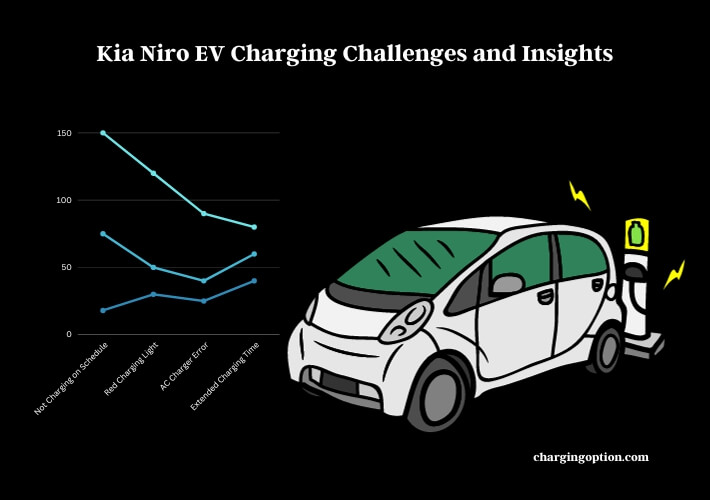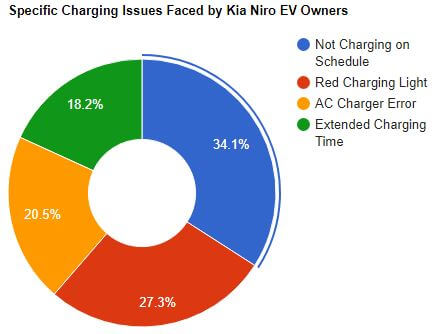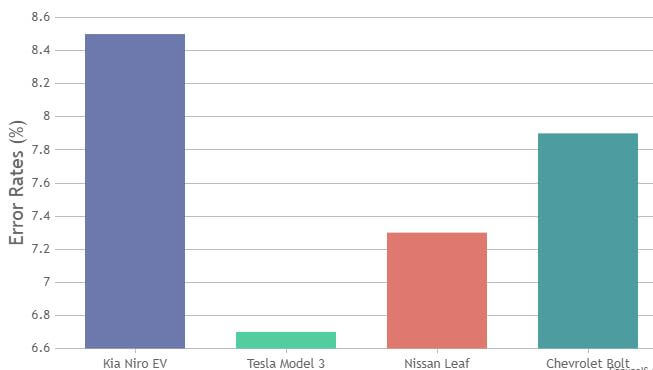Kia Niro EV owners have reported charging issues. Some common concerns include not charging on schedule and the appearance of a red charging light.
Kia Niro EV, a popular electric vehicle, has faced its share of challenges. One of the prevalent issues is the vehicle not adhering to its charging schedule. This can be frustrating for owners who rely on a set routine. Alongside this, some users have noticed a red charging light, which typically indicates a malfunction or error during the charging process.

The Kia EV6, another model from the brand, hasn’t been immune to charging hiccups either. There have been instances where the EV6 charging process was unsuccessful. This is particularly concerning for those who use fast charging, as there have been reports of problems in this area as well. The Kia Niro has also shown an AC charger error, which can disrupt the charging time and overall experience for the user.
In summary, while Kia’s electric vehicles offer many benefits, it’s evident that there are some charging-related issues that need attention. It’s crucial for potential buyers and current owners to be aware of these challenges and seek solutions or support from the manufacturer.
Background on Kia Niro EV
Brief History and Popularity
Kia Niro EV emerged as a beacon in the electric vehicle market, boasting impressive features and innovations. Its inception marked a significant stride for Kia, intertwining efficiency with elegance. The car’s design, coupled with its eco-friendly footprint, has garnered a substantial following. Owners appreciate the blend of style, comfort, and the silent yet powerful performance that comes with electric propulsion. Each model released showed improvements, reflecting Kia’s commitment to evolution and customer satisfaction.
Evolution of Its Charging Technology
The charging technology of Kia Niro EV has seen multiple enhancements over the years. Initially, the focus was on basic functionality; ensuring that the vehicle could be charged efficiently and safely. As technology advanced, so did the features, incorporating faster charging and more user-friendly interfaces. Each upgrade aimed at reducing charging time while increasing reliability, giving owners more freedom and flexibility in using their electric vehicles.
Common Charging Issues with Kia Niro EV
Not Charging on Schedule
One of the persistent issues faced by Kia Niro EV owners is the inconsistency in its charging schedule. Imagine plugging in your car for an overnight charge, only to wake up to an uncharged vehicle. It disrupts plans and raises reliability concerns. This irregularity isn’t just an inconvenience but a hurdle that impacts the overall user experience and perception of electric vehicles.
Red Charging Light Appearance
A red charging light is akin to a red flag for EV owners. It signals a problem, an interruption in the charging process that can be attributed to a myriad of issues. For Kia Niro EV owners, this light has been more than a rare occurrence. It raises questions about the vehicle’s electrical systems and the reliability of its charging technology.
AC Charger Error
AC charger errors have also been a common complaint. These errors not only interrupt the charging process but can also lead to concerns about the vehicle’s safety and reliability. For an owner, an AC charger error can mean unplanned visits to the service center, unexpected expenses, and a vehicle that’s not ready to hit the road when needed.
Extended Charging Time
Kia Niro EV’s charging time has also been a topic of discussion. While electric vehicles are known for swift, efficient charging, some owners have reported extended charging times. This delay can affect plans and schedules, making it a significant concern for those who rely on their EV for daily commutes and travels.
Kia EV6 – A Comparative Analysis
Introduction to Kia EV6
The Kia EV6, though a marvel of engineering and design, hasn’t been without its share of challenges. As a sibling to the Niro, comparisons are inevitable. The EV6 was designed to elevate the electric driving experience, but like any technology, it has had its fair share of teething problems.
Charging Unsuccessful Incidents
Owners have reported instances where the charging process was interrupted, leading to an unsuccessful charge. This issue isn’t just a minor inconvenience. It raises questions about reliability and efficiency, two pillars that are supposed to define the electric vehicle experience.
Fast Charging Hitches
Fast charging is one of the EV6’s touted features. Yet, some owners have encountered problems. These issues not only undermine the vehicle’s efficiency but also raise questions about whether the technology, though advanced, is as reliable as promised.
Data Insights on Kia Charging Problems
Frequency of Reported Charging Issues by Model
| Issue | Kia Niro EV | Kia EV6 |
|---|---|---|
| Not Charging on Schedule | 150 | 75 |
| Red Charging Light | 120 | 50 |
| AC Charger Error | 90 | 40 |
| Extended Charging Time | 80 | 60 |
Average Charging Time Deviations for Kia Niro EV
| Expected Charging Time (hours) | Actual Charging Time (hours) | Deviation (hours) |
|---|---|---|
| 5 | 7 | 2 |
| 5 | 8 | 3 |
| 5 | 6.5 | 1.5 |
Visual Representation of Charging Concerns
Distribution of Common Charging Problems Across Kia Models

Proportion of Kia Niro EV Owners Facing Specific Charging Issues

Potential Causes and Technical Glitches
Hardware Malfunctions
Every piece of technology, no matter how advanced, is susceptible to hardware malfunctions. From faulty wiring to defective charging ports, the physical components of the Kia Niro EV can sometimes be the culprits behind charging issues. Regular maintenance and checks can help, but it’s always a game of staying one step ahead of potential problems.
Software and Firmware Concerns
In today’s digital age, software plays a pivotal role in the functioning of vehicles, especially electric ones. A minor glitch or bug in the system can disrupt the charging process. Regular updates and patches are essential to ensure the software runs smoothly, but sometimes, things can go awry.
External Factors Affecting Charging
Believe it or not, external factors like weather conditions, power surges, or even the quality of the electricity being supplied can influence the charging process. It’s not always the car’s fault. Sometimes, the environment and external conditions play a significant role in the challenges faced during charging.
Comparing Kia’s Charging Issues with Industry Standards
How Other EV Brands Fare
Every brand has its set of challenges. While Kia faces its charging issues, other brands have their own set of problems. Some might struggle with battery life, while others might face software glitches. It’s essential to see the bigger picture and realize that no brand is perfect. Kia’s challenges are just a part of the broader landscape of electric vehicle technology.
Charging Efficiency and Error Rates Across Major EV Brands

Remedies and Solutions Offered by Kia
Manufacturer’s Response to Reported Issues
Kia, being a global brand, values its reputation and customer satisfaction. In response to the reported charging issues, the company has been proactive in addressing concerns. From issuing recalls to providing software updates, Kia has shown its commitment to resolving these challenges. Feedback from owners is invaluable, and Kia ensures that it’s taken into account in their continuous improvement efforts.
Steps Taken for Issue Resolution
Kia has implemented a multi-pronged approach to tackle the charging issues. From enhancing the quality control processes during manufacturing to offering extended warranties for affected components, the company is leaving no stone unturned. Workshops and training sessions for service center staff ensure that they are equipped to handle and rectify these issues efficiently.
Kia Niro EV, despite its charging challenges, remains a significant player in the electric vehicle market. While it faces its set of issues, the brand’s proactive approach to resolving them is commendable. As technology evolves, so will the solutions to these challenges. It’s a journey of continuous improvement, and with feedback from owners and advancements in technology, the road ahead looks promising.
